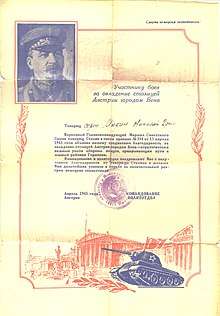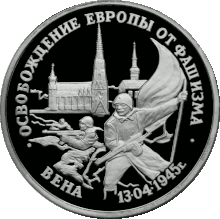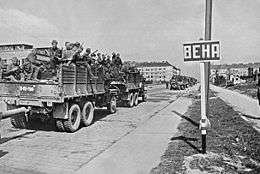Vienna Offensive
The Vienna Offensive was launched by the Soviet 2nd and 3rd Ukrainian Fronts in order to invade Vienna, Austria, during World War II. The offensive lasted from 2 April to 13 April 1945.
The Soviets placed the city under siege, facing only a single Panzer corps. After a few days’ street fighting, the defenders had destroyed all but two of the Danube bridges, and the Panzers escaped encirclement. The incoming Soviets devastated the old city, and there was much brutality against civilians. Stalin approved the restoration of Austria as a sovereign country.
Background
Joseph Stalin reached an agreement with the Western Allies prior to April 1945 concerning the relative postwar political influence of each party in much of Eastern and Central Europe; however, these agreements said virtually nothing about the fate of Austria, then officially considered to be merely the Ostmark area of Greater Germany after the Anschluss. As a result, the victory of a Soviet offensive toward Austria and the liberation by the Red Army of a large part of this country would have been very beneficial for subsequent postwar negotiations with the Western Allies.[6]
After the failure of Operation Spring Awakening (Unternehmen Frühlingserwachen), Sepp Dietrich's 6th SS Panzer Army retreated in stages to the Vienna area.[7] The Germans desperately prepared defensive positions in an attempt to guard the city against the rapidly arriving Soviets.
In Spring 1945, the advance of Soviet General Fyodor Tolbukhin's 3rd Ukrainian Front through western Hungary gathered momentum on both sides of the Danube.[8] After they took Sopron and Nagykanizsa, they crossed the border between Hungary and Austria.[9]
On 25 March, the 2nd Ukrainian Front launched the Bratislava–Brno Offensive by crossing the Hron river. On 30 March the Front crossed also the Nitra River and quickly rushed across the Danubian Lowland towards Bratislava. Having secured his right wing by 2nd Ukrainian Front, Tolbukhin was now ready to advance into Austria and take Vienna.
The battle
On 2nd April, Vienna Radio denied that the Austrian capital had been declared an open city. On the same day, Soviet troops approached Vienna from the south after they overran Wiener Neustadt, Eisenstadt, Neunkirchen and Gloggnitz.[9] Baden and Bratislava were overrun on 4 April.
After arriving in the Vienna area, the armies of the Soviet 3rd Ukrainian Front surrounded, besieged, and attacked the city. Involved in this action were the Soviet 4th Guards Army, the Soviet 6th Guards Tank Army, the Soviet 9th Guards Army, and the Soviet 46th Army. The "O-5 Resistance Group," Austrians led by Carl Szokoll, wanting to spare Vienna destruction, actively attempted to sabotage the German defenses and to aid the entry of the Red Army.
The only major German force facing the Soviet attackers was the German II SS Panzer Corps of the 6th SS Panzer Army, along with ad hoc forces made up of garrison and anti-aircraft units. Declared a defensive region, Vienna's defense was commanded by General Rudolf von Bünau, with the II SS Panzer Corps units under the command of SS General Wilhelm Bittrich.
The battle for the Austrian capital was characterized in some cases by fierce urban combat, but there were also parts of the city the Soviets advanced into with little opposition. Defending in the Prater Park was the 6th Panzer Division, along the south side of the city were the 2nd and 3rd SS Panzer Divisions, and in the north was the Führer-Grenadier Division.[10] The Soviets assaulted Vienna's eastern and southern suburbs with the 4th Guards Army and part of the 9th Guards Army. The German defenders kept the Soviets out of the city’s southern suburbs until 7 April. However, after successfully achieving several footholds in the southern suburbs, the Soviets then moved into the western suburbs of the city on 8 April with the 6th Guards Tank Army and the bulk of the 9th Guards Army. The western suburbs were especially important to the Soviets because they included Vienna's main railway station. The Soviet success in the western suburbs was followed quickly by infiltration of the eastern and northern suburbs later the same day. North of the Danube River, the 46th Army pushed westward through Vienna's northern suburbs. Central Vienna was now cut off from the rest of Austria.
By the 9th of April, the Soviet troops began to infiltrate the center of the city, but the street fighting continued for several more days. On the night of 11 April, the 4th Guards Army stormed the Danube canals, with the 20th Guards Rifle Corps and 1st Mechanized Corps moving on the Reichsbrücke Bridge. In a coup de main on 13 April, the Danube Flotilla landed troops of the 80th Guards Rifle Division and 7th Guards Airborne Division on both sides of the bridge, cutting demolition cables and securing the bridge.[lower-alpha 3] However, other important bridges were destroyed. Vienna finally fell when the last defenders in the city surrendered on the same day.[lower-alpha 4] Bittrich's II SS Panzer Corps, however, pulled out to the west on the evening of 13 April to avoid encirclement.[11] The same day, the 46th Army took Essling and the Danube Flotilla landed naval infantry up the river by Klosterneuburg.
While the street fighting was still intensifying in the southern and western suburbs of Vienna on 8 April, other troops of the 3rd Ukrainian Front by-passed Vienna altogether and advanced on Linz and Graz.[9]
On the 10th, all but two of the bridges in the city had been destroyed. The Floridsdorf bridge had been left intact by a Fuehrer Order dictating that the bridge be held at all costs. The 2nd SS Panzer, "Das Reich" left a dozen artillery pieces including 37mm anti-aircraft guns to hold off enemy attacks. That night, the "Das Reich", including their last remaining three dozen armored vehicles, pulled out of the city for the last time. Vienna had fallen, and the Germans now moved northwest to hold the next defensive line.[12]
Aftermath

By 15 April, armies of the Soviet 3rd Ukrainian Front pushed even further into Austria. The completely exhausted remnants of what had been the 6th SS Panzer Army were forced to flee to the area between Vienna and Linz. Just behind the retreating Germans were elements of the Soviet 9th Guards Army and the Soviet 46th Army. The 26th Army and 27th Armies advanced towards the area north of Graz just behind the retreating 6th Army. The 57th Army and the Bulgarian 1st Army advanced towards the area south of Graz (near Maribor) just behind the retreating 2nd Panzer Army. None of these German armies were in any shape to do more than temporarily stall the advancing Soviet forces.
Some of Vienna's finest buildings lay in ruins after the battle. There was no water, electricity, or gas — and bands of people, both foreigners and Austrians, plundered and assaulted the helpless residents in the absence of a police force. While the Soviet assault forces generally behaved well, the second wave of Soviet troops to arrive in the city were reportedly badly undisciplined. A large number of lootings and cases of rape took place in a several-week long violence that has been compared to the worst aspects of the Thirty Years War.[13]
Like Bittrich, General von Bünau left Vienna before it fell to avoid capture by the Soviets. From 16 April until the war's end, he led Generalkommando von Bünau, surrendering to the Americans on VE Day. von Bünau was held as a POW until April 1947. Bittrich also surrendered to U.S. forces and was held as a prisoner by the Allies until 1954. Fyodor Tolbukhin went on to command the Soviet Southern Group of Forces and the Transcaucasian Military District until his death in 1949.
Austrian politician Karl Renner astutely set up a Provisional Government in Vienna sometime in April with the tacit approval of the victorious Soviet forces,[14] and declared Austria's secession from the Third Reich.
Final orders of battle (after the Vienna Offensive)
Axis Forces
On 30 April, the following order of battle was recorded by the German Army High Command (Oberkommando der Wehrmacht, or OKW). From 20 April-2 May, OKW moved from Zossen (near Berlin) to Mürwik (part of Flensburg in north Germany, near Denmark).[15] This order of battle shows what remained "on paper" of the German armies that fought in Hungary and Austria.
- German 6th SS Panzer Army – east of Linz
- 117th Jäger Division (arriving)
- I SS Panzer Corps
- 1st SS Panzer Division
- 12th SS Panzer Division[12]
- II SS Panzer Corps
- 2nd SS Panzer Division
- 9th SS Panzer Division Hohenstaufen[12]
- Führer Grenadier Division
- German 6th Army – north of Graz
- IV SS Panzer Corps
- 3rd SS Panzer Division Totenkopf
- 5th SS Panzer Division
- 14th SS Grenadier Division
- III Panzer Corps
- IV SS Panzer Corps
- German 2nd Panzer Army – south of Graz (near Maribor)
- LXVIII Corps
- 71st Infantry Division
- 13th SS Alpine Division
- 118th Jäger Division
- XXII Mountain Corps
- 297th Infantry Division
- Hungarian Szent László Infantry Division
- I Cavalry Corps
- 23rd Panzer Division
- 4th Cavalry Division
- 3rd Cavalry Division
- 16th SS Panzergrenadier Division
- LXVIII Corps
Soviet and Soviet allied forces

The order of battle for the 3rd Ukrainian Front during the same period was:
- 4th Guards Army
- 20th Guards Rifle Corps
- 5th Guards Airborne Division
- 7th Guards Airborne Division
- 80th Guards Rifle Division
- 21st Guards Rifle Corps
- 41st Guards Rifle Division
- 62nd Guards Rifle Division
- 66th Guards Rifle Division
- 69th Guards Rifle Division
- 31st Guards Rifle Corps
- 20th Guards Rifle Corps
- 6th Guards Tank Army
- 5th Guards Tank Corps
- 9th Guards Mechanized Corps
- 9th Guards Army
- 37th Guards Rifle Corps
- 98th Guards Rifle Division
- 99th Guards Rifle Division
- 103rd Guards Rifle Division
- 38th Guards Rifle Corps
- 104th Guards Rifle Division
- 105th Guards Rifle Division
- 106th Guards Rifle Division
- 39th Guards Rifle Corps
- 100th Guards Rifle Division
- 107th Guards Rifle Division
- 114th Guards Rifle Division
- 37th Guards Rifle Corps
- 26th Army
- 30th Rifle Corps
- 104th Rifle Corps
- 74th Rifle Division
- 93rd Rifle Division
- 151st Rifle Division
- 135th Rifle Corps
- 233rd Rifle Division
- 236th Rifle Division

- 27th Army
- 35th Guards Rifle Corps
- Guards Airborne Division
- 163rd Rifle Division
- 202nd Rifle Division
- 33rd Rifle Corps
- 78th Rifle Division
- 155th Rifle Division
- 206th Rifle Division
- 337th Rifle Division
- 37th Rifle Corps
- 108th Guards Rifle Division
- 316th Rifle Division
- 320th Rifle Division
- 35th Guards Rifle Corps
- 57th Army
- 6th Guards Rifle Corps
- 10th Guards Airborne Division
- 20th Guards Rifle Division
- 61st Guards Rifle Division
- 64th Rifle Corps
- 73rd Guards Rifle Division
- 113th Rifle Division
- 299th Rifle Division
- 133rd Rifle Corps
- 84th Rifle Division
- 104th Rifle Division
- 122nd Rifle Division
- 6th Guards Rifle Corps
- 17th Air Army
- 5th Guards Cavalry Corps
- 1st Guards Mechanized Corps
- 18th Tank Corps
- 2nd Breakthrough Artillery Corps
- 9th Breakthrough Artillery Division
- 19th Breakthrough Artillery Division
- 7th Breakthrough Artillery Division
- 3rd Anti-aircraft Artillery Division
- 4th Anti-aircraft Artillery Division
- 9th Anti-aircraft Artillery Division
- 22nd Anti-aircraft Artillery Division
- 1st Bulgarian Army
- III Corps
- 10th Infantry Division
- 12th Infantry Division
- 16th Infantry Division
- IV Corps
- 3rd Infantry Division
- 8th Infantry Division
- 11th Infantry Division
- 6th Infantry Division
- III Corps
See also
- Anschluss
- Battle of Berlin
- Bombing of Vienna in World War II
- Eastern Front (World War II)
- History of Germany during World War II
- Battle of Budapest – 1944/45
- Operation Frühlingserwachen – 1945
- Battle of the Transdanubian Hills – 1945
- Nagykanizsa–Körmend Offensive – 1945
- Prague Offensive – 1945
- Soviet 3rd Ukrainian Front
- German 6th SS Panzer Army
- End of World War II in Europe
- Siege of Vienna (1529)
- Battle of Vienna (1683)
Explanatory notes
- Nearly all were abandoned due to a lack of fuel. Only a fraction were destroyed in combat.[4]
- Site soldat.ru lists casualties of 139,815 for the 3rd Ukrainian Front and 9,805 for the 1st Bulgarian Army for the period 16 March to 15 April 1945.
- Former members of O-5 tell a different story, claiming the bridge guards were actually O-5 members who turned their machine-guns on the Germans when they attempted to destroy the bridge. Toland 1965, p. 354.
- Descriptions of Soviet actions are from Ustinov 1982, pp. 238–239.
References
- Frieser et al. 2007, p. 943.
- Tucker-Jones, Anthony (2016). The Battle for Budapest. ISBN 978-1473877320.
- Frieser et al. 2007, p. 953.
- Frieser et al. 2007, p. 952.
- .
- Berzhkov 1987, Chapter 5, Section 2.
- Dollinger & Jacobsen 1968, p. 199.
- Laffin 1995, p. 449.
- Dollinger & Jacobsen 1968, p. 182.
- Gosztony 1978, p. 261.
- Gosztony 1978, p. 262.
- Reynolds, Michael (2009). Sons of the Reich: II SS Panzer Corps. Barnsley: Pen & Sword Military. ISBN 978-184884-000-3.
- Gosztony 1978, p. 263.
- Johnson 1989, pp. 135–136.
- Dollinger & Jacobsen 1968, p. 177.
Sources
- Berzhkov, Velentin Mikhailovic (1987). Страницы дипломатической истории [The History of Diplomacy]. Moskva: Международные отношения.CS1 maint: ref=harv (link)
- Laffin, John (1995). Brassey's Dictionary of Battles. New York: Barnes and Noble. ISBN 0-7607-0767-7.CS1 maint: ref=harv (link)
- Dollinger, Hans; Jacobsen, Hans Adolf (1968). The Decline and Fall of Nazi Germany and Imperial Japan. New York: Crown.CS1 maint: ref=harv (link)
- Frieser, Karl-Heinz; Schmider, Klaus; Schönherr, Klaus; Schreiber, Gerhard; Ungváry, Kristián; Wegner, Bernd (2007). Die Ostfront 1943/44 – Der Krieg im Osten und an den Nebenfronten [The Eastern Front 1943–1944: The War in the East and on the Neighbouring Fronts]. Das Deutsche Reich und der Zweite Weltkrieg [Germany and the Second World War] (in German). VIII. München: Deutsche Verlags-Anstalt. ISBN 978-3-421-06235-2.CS1 maint: ref=harv (link)
- Gosztony, Peter (1978). Endkampf an der Donau 1944/45 (in German). Wien: Molden Taschenbuch Verlag. ISBN 3-217-05126-2.CS1 maint: ref=harv (link)
- Johnson, Lonnie (1989). Introducing Austria. Riverside: Ariadne Press. ISBN 978-0-929497-03-7.CS1 maint: ref=harv (link)
- Jukes, Geoffrey (2002). The Second World War (5): The Eastern Front 1941–1945. Osprey Publishing. ISBN 1-84176-391-8.CS1 maint: ref=harv (link)
- Ustinov, D. F. (1982). Geschichte des Zweiten Welt Krieges (in German). 10. Berlin: Militärverlag der DDR.CS1 maint: ref=harv (link)
- Toland, John (1965). The Last 100 Days. New York: Random House.CS1 maint: ref=harv (link)
Further reading
- Glantz, David (11 October 2001). "The Soviet‐German War 1941–45: Myths and Realities: A Survey Essay" (PDF). Clemson University.
